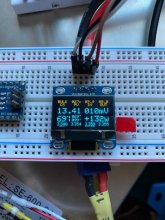This is working well, would highly recommend anyone trying to remote enable/disable over VE direct to just spend a couple of bucks on a microcontroller. Can add some $0.50 temp sensors to give it more purpose if you don't have a smart bms to also integrate with. I had this old display laying around so I figured why not-even though I have a perfectly good serial monitor and won't be using the screen in any of my setups.
This particular project is using a BlueSolar MPPT so it lacks bluetooth communication. The victron dongle I bought years ago was the older version so it doesn't support VE Smart networking

- thus it's only good for using the victron app, not communicating with a smart battery sense or BMV.
This MPPT is actually in a ventilated (temp controller module on load output to exhaust fan) small pelican case with panel mount connections for PV and battery. It charges up several of my portable packs that I didn't want to dedicate an MPPT to (I do have two big batteries that do have their own SmartSolar ccs though). The problem in using it like this is that the packs have different wiring and connections, so the resistance is different. Meaning if I set absorption to 14.2v (which on one portable pack nails 13.8v
actual on the nose), it over or undershoots on other packs.
All of my batteries use chinese smart bms units so all I have to do is install 3 pin aviation connectors on the portable packs, and one on the portable MPPT box with the microcontroller. Can do my own double-safety temperature cutoff based on BMS temps and set my absorption voltages to a higher number than I'd prefer but that still won't exceed 3.65vpc on any pack. When the pack's BMS says a cell has hit the max I want it to go to the MPPT is disabled - future plans to try and taper max charge current to let bms balance easier and get every cell to where I want it.
So yea that's about $5 in parts to make a Victron mppt smarter than it already was and respect cell voltages as reported by BMS. My big setups that have dedicated MPPTs are running SmartSolar offerings and already doing all of the above with their own microcontrollers, as they still have ve direct ports. The bluetooth still works on those despite being talked to through ve direct, as does smart networking (those have BMVs transmitting temp and more accurate voltage).

another cool thing is being able to differentiate what's going in versus what's going out, since I know the MPPT charge current. That's a feature that I wish the BMV could accomplish, because if you're using 50w and charging at 50w you'll simply see 0 and have to flip to MPPT in app to see what's really happening there. The smart bms' also have the same limitation as the BMV in this respect.
But anyway, '09.9 In' is what the MPPT is charging at. '00.0 Out' is where the actual discharge current is calculated based on MPPT in and BMS current reading. +132w is the net going either in or out. Large underline vs small underline on cell voltages indicates min/max, delta, temp, battery voltage which flips every 5 seconds to show SOC%. Pretty cool. I'll put it on github some day.



